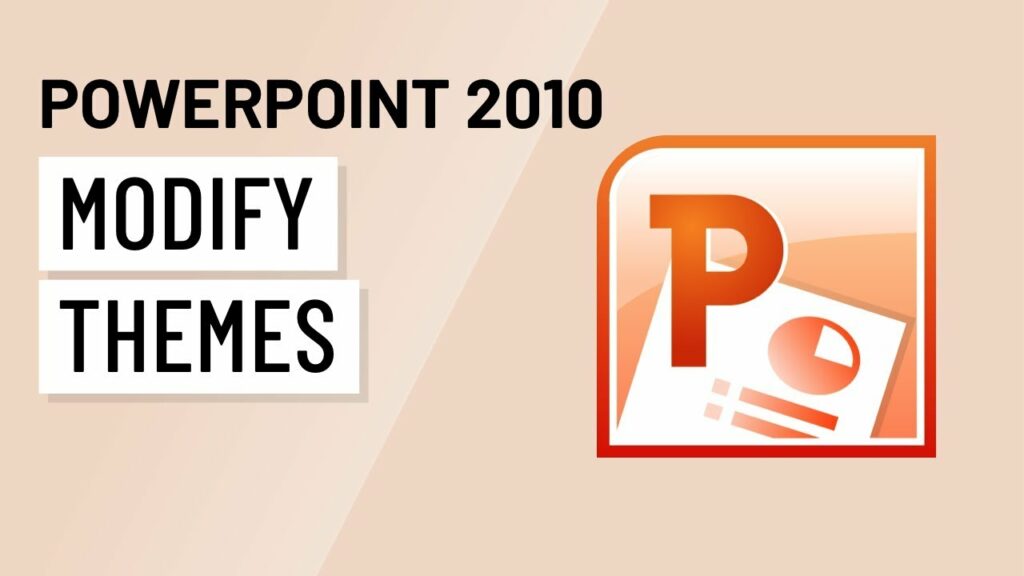Mastering Visual Harmony: An In-Depth Exploration of Modifying Themes in Microsoft PowerPoint 2010

Introduction:
Microsoft PowerPoint has long been a cornerstone in the world of presentations, allowing users to convey information in a visually compelling manner. One of the key features that contribute to the aesthetic appeal of presentations is the ability to modify themes. In this comprehensive guide, we will delve into the nuanced world of modifying themes in Microsoft PowerPoint 2010, exploring the vast array of tools and techniques available to users for creating presentations that not only inform but captivate through cohesive and visually pleasing design.
Understanding the Essence of Themes:
- Introduction to Themes: Themes in PowerPoint are comprehensive design templates that encompass the visual elements of a presentation. From color schemes and fonts to background styles and slide layouts, themes provide a unified and professional look to your slideshows. PowerPoint 2010 comes equipped with a range of pre-designed themes, each catering to different presentation styles and purposes.
- Accessing Themes in PowerPoint 2010: To explore and modify themes in PowerPoint 2010, users can navigate to the Design tab. Here, a gallery of pre-built themes is available, offering a quick way to transform the overall look of a presentation. Users can hover over each theme to preview how it affects the slides before making a selection.
Basic Theme Modifications:
- Changing Theme Colors: PowerPoint 2010 allows users to modify the color scheme of a theme easily. By clicking on the Colors drop-down menu within the Design tab, users can choose from a variety of color options or create custom color schemes. This customization ensures that the presentation aligns with branding guidelines or personal preferences.
- Altering Font Styles: Font styles play a crucial role in the readability and visual coherence of a presentation. Under the Fonts drop-down menu on the Design tab, users can select different font combinations to enhance the overall aesthetic. This feature is especially useful for maintaining a consistent look and feel throughout the slides.
- Background Styles and Effects: Modifying the background is another way to personalize a presentation. Users can experiment with background styles and effects by accessing the Background Styles options within the Design tab. This includes variations in color, gradients, or even the addition of background images for a more dynamic and visually engaging backdrop.
Advanced Theme Customizations:
- Creating Custom Themes: PowerPoint 2010 empowers users to go beyond pre-built themes by creating their own custom themes. In the Design tab, under the Themes group, users can click on the More button to access the “Save Current Theme” option. This allows for the saving of custom color schemes, fonts, and effects as a new theme, ensuring a unique and branded presentation style.
- Modifying Slide Master: For a more granular level of control over the presentation’s design, users can explore the Slide Master. Located in the View tab, the Slide Master allows for global modifications to the layout, fonts, and colors across all slides. This is particularly useful for maintaining a consistent look, especially in presentations with numerous slides.
- Applying Transitions and Animations: While often associated more with individual slides, transitions and animations contribute to the overall visual appeal of a presentation. By experimenting with different transition styles and animation effects, users can add a touch of sophistication to their slides, ensuring a seamless and engaging flow from one slide to the next.
- Incorporating Multimedia Elements: PowerPoint 2010 allows for the integration of multimedia elements such as audio and video. When modifying themes, users can consider incorporating these elements strategically. This adds an extra layer of engagement and ensures that the presentation caters to diverse learning preferences.
Collaborative Theme Modifications:
- Sharing Themes Across Presentations: PowerPoint 2010 facilitates collaboration by enabling users to share themes across different presentations. By saving a modified theme, users can export it and import it into other presentations, ensuring a consistent visual identity across various projects.
- Ensuring Accessibility: In the process of modifying themes, it is crucial to consider accessibility. PowerPoint 2010 provides features like accessible themes and alternative text for images to ensure that presentations are inclusive and can be understood by a diverse audience.
Conclusion:
In conclusion, the ability to modify themes in Microsoft PowerPoint 2010 is a powerful tool that empowers users to create visually stunning and cohesive presentations. From simple adjustments in color and font to the creation of custom themes and advanced modifications in the Slide Master, PowerPoint provides a wealth of options for users to express their creativity and ensure a professional and engaging visual experience. By mastering the art of theme modification, presenters can elevate their slideshows, leaving a lasting impression on their audience and conveying information with style and impact.





